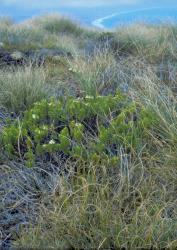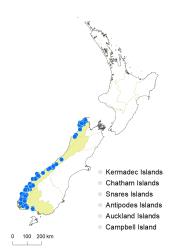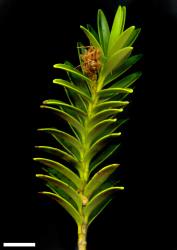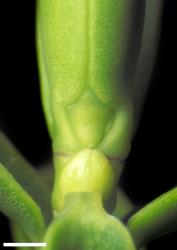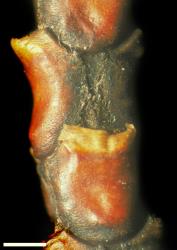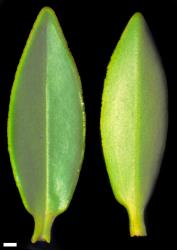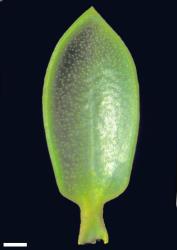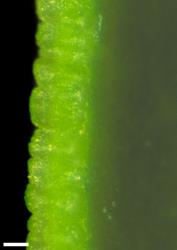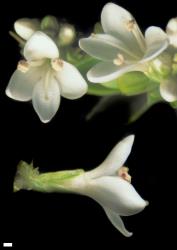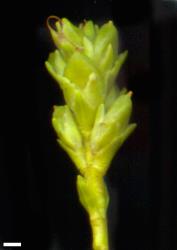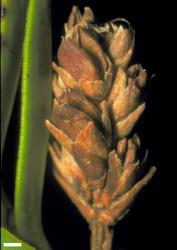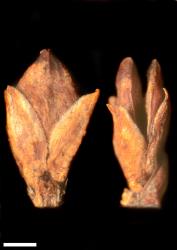- ≡ Leonohebe mooreae Heads, Bot. Soc. Otago Newsl. 5: 10 (1987)
- ≡ Hebe mooreae (Heads) Garn.-Jones, Austral. Syst. Bot. 6: 479 (1993)
- = Leonohebe mooreae var. telmata Heads, Bot. Soc. Otago Newsl. 5: 10 (1987)
Shrub to 1.2 m tall or rarely to 2.0 m. Stems erect, eglandular-pubescent, hairs bifarious. Leaf bud distinct, its leaves appressed at margins until fully grown; sinus shield-shaped to rhomboid, or sometimes narrow and acute. Leaves opposite-decussate, erecto-patent; lamina coriaceous, rigid, oblong, oblong-elliptic, oblong-lanceolate, or linear-oblong, 7–28 mm long, 3–8 mm wide, glossy dark green above, somewhat glossy green to dark green beneath; midrib and two lateral veins evident; surfaces glabrous; margin glabrous, entire but minutely crenulate; apex acute or sub-acute; base steeply cuneate to truncate; petiole 1–3 mm long. Inflorescence a lateral spike or raceme, 8–30 mm long; flowers crowded, 3–13, all bisexual; bracts opposite-decussate, connate, ovate or deltoid, > pedicels; pedicels erect, 0–1 mm long, sparsely eglandular-pubescent all around. Calyx lobes 4, anterior pair sometimes fused in lower ⅓, obtuse to sub-acute, 3–4 mm long, sub-equal, eglandular-ciliolate or mixed glandular- and eglandular-ciliolate. Corolla 10–12 mm diameter; tube white, 4–5 mm long, ≥ calyx; glabrous or with mixed eglandular and glandular hairs inside; lobes 4, white, erecto-patent to recurved, sub-equal, elliptic to broadly elliptic, 5–6 mm long, obtuse to rounded; nectar guides absent. Stamen filaments white, 3–4 mm long; anthers pink or pale pink. Style glabrous, 5.5–8.5 mm long. Capsules latiseptate, acute or sub-acute, glabrous, 3.5–4.5 mm long, 2.0–2.8 mm at widest point. Seeds broadly ellipsoid, flattened, smooth, pale brown, 1.2–1.8 mm long.
odora | mooreae | pauciramosa | masoniae | venustula | brachysiphon | |
|---|---|---|---|---|---|---|
Leaf bud sinus | broad, shield-shaped | narrow & acute to broad & shield shaped | broad, shield-shaped | broad, shield-shaped | narrow, acute | narrow, acute |
Leaf margin | sharply bevelled; glabrous | bevelled at 90º to surfaces, glabrous | rounded; glabrous or with minute hairs or denticles | rounded, papillate towards apex; ciliolate when young | weakly bevelled; ciliolate when young, becoming glabrous or papillate | weakly bevelled; ciliolate to ciliate when young, becoming papillate |
Stomata | adaxial – (but often + at Arthur’s Pass); abaxial + | adaxial – (+ at Caswell Sound, Denniston); abaxial + | adaxial +; abaxial + | adaxial +; abaxial + | adaxial ±; abaxial + | adaxial ±; abaxial + |
Midrib | sharply keeled beneath | depressed above; prominent beneath | rounded beneath and flattened just short of apex | keeled throughout | evident but not keeled | evident but not keeled |
Inflorescence | terminal + usually lateral spikes | lateral spikes only | lateral spikes only | terminal spikes only | lateral raceme, sometimes ternate, rarely compound. | lateral raceme, sometimes ternate. |
Bracts | not overtopping calyx | < calyx | < calyx | ≥ calyx | ≥ pedicels, < calyx | ≥ pedicels, < calyx |
Bracts and flowers | opposite | opposite | opposite | opposite | opposite below, becoming alternate | alternate, or lowermost opposite |
Pedicels | 0 mm | 0–1 mm | 0–0.5 mm | 0 mm | 0.5–7.0 mm | 0.6–3.0 mm |
Calyx, anterior lobes | free | free or fused to ⅓-way | fused > ⅔-way | free | free | free |
Corolla lobes | narrow | broad | narrow | broad | ± broad | ± broad |
South Island: Western Nelson (western mountains, Gouland Downs), Westland (Denniston Plateau and south of Mt Wilberg), Fiordland, Southland (Hump Ridge and Longwood Range).
Records from Canterbury (Wild Mans Brother Range, Cameron River, Laing, WELT17242) and Otago (East Dome, CHR 4138; regarded as anomalous by Bayly & Kellow 2006) are not mapped here.
Penalpine grassland and montane to sub-alpine scrub. Recorded elevations range from 500 to 1385 m.
Flowers: November–February, sometimes to June); fruits: January–June (sometimes persisting to be present all year).
2n = 126 (see Bayly & Kellow 2006, as Hebe mooreae).
Veronica mooreae is classified in V. subg. Pseudoveronica sect. Hebe and the informal group “Buxifoliatae” (Albach & Meudt 2010; Bayly & Kellow 2006). The phylogenetic relationships of V. mooreae are not well resolved. On the basis of ITS sequence data, it falls within a large, unresolved grouping of shrubby hebes that have 2n = 40, 80, 120, not close to V. odora (2n = 42, 84), with which it was previously confused. Its unusual chromosome number (2n = 126) suggests it might have a hybrid origin, and it is possible that one of its parent species is V. odora.
The thickened leaf margins are usually bevelled at about 90° to the surfaces, and their minute crenulations are visible with a lens or can be felt by rubbing a fingernail along the margin.
Plants from Gouland Downs have long internodes and slender leaves that are almost linear-elliptic.



